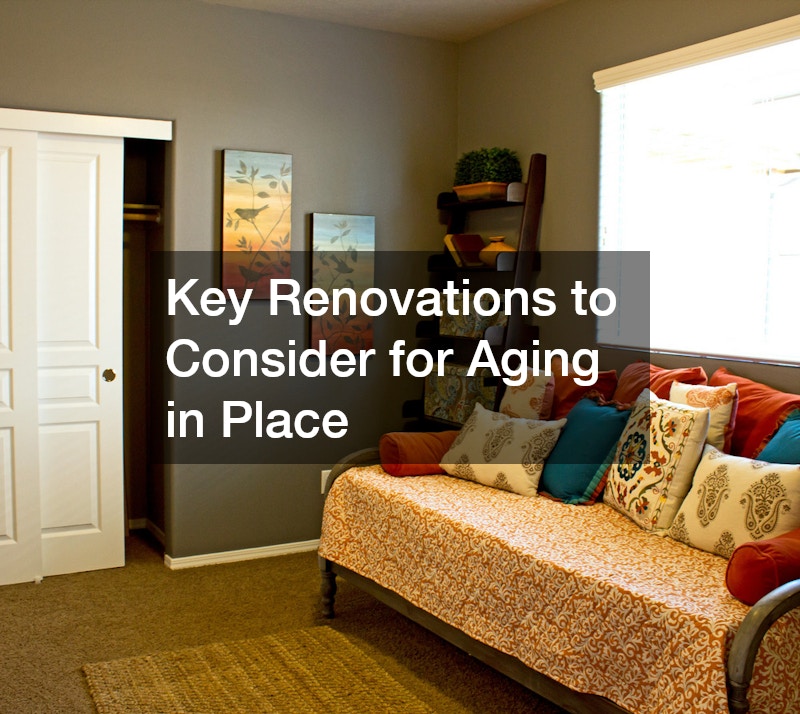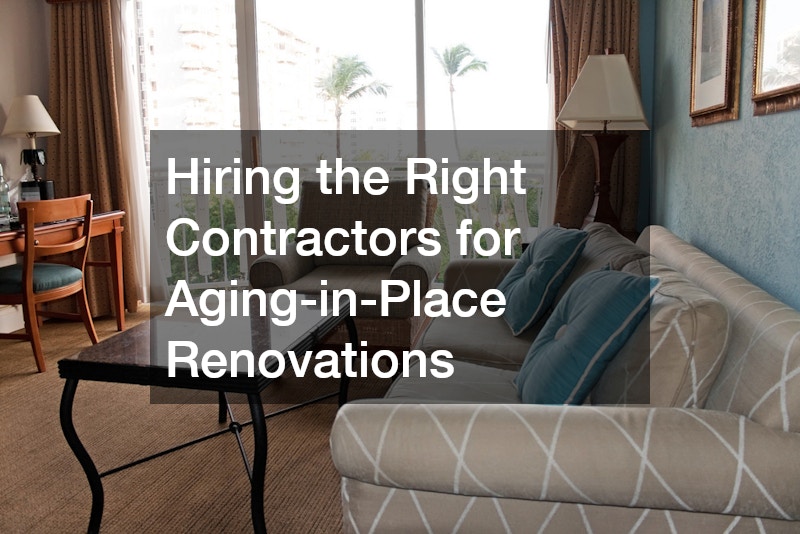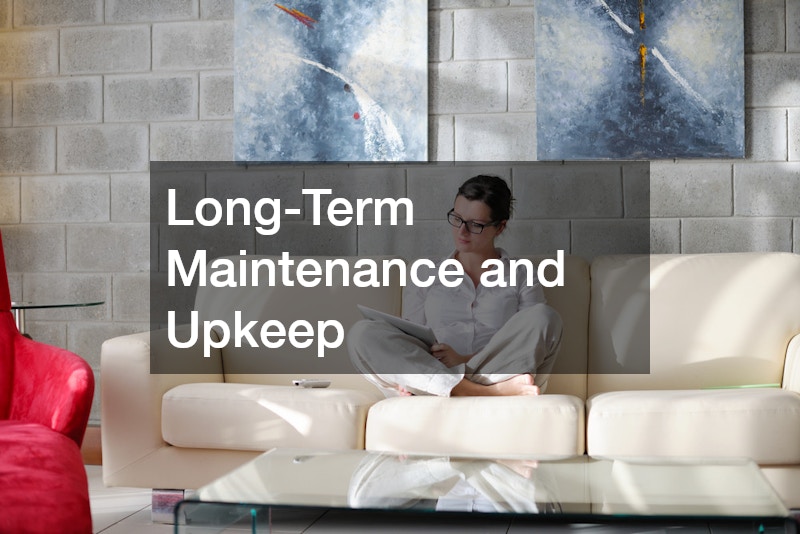Aging in place refers to the ability to live in your home independently as you grow older. It allows you to stay in a familiar environment, close to family and friends, while still receiving the support you need to thrive. As the population of seniors continues to rise, home renovations for aging in place are becoming increasingly important. With the right modifications, your home can remain a safe, comfortable space well into your golden years.
Renovating your home for aging in place not only enhances your daily living but also allows you to maintain independence and dignity as you age. In this blog, we will explore the benefits of renovating your home to ensure it accommodates the changes that come with aging, and offer insights into the specific home improvements that can make a significant difference.

1. Understanding Aging in Place: What Does It Mean?
Aging in place is a term that refers to remaining in your home and community as you age, rather than moving to a nursing home or assisted living facility. It means adapting your home to meet the evolving needs of aging, ensuring that it is safe, functional, and comfortable for the long term.
Some of the key benefits of renovating your home to accommodate aging in place include increased safety, greater comfort, and the ability to remain in a familiar environment. For many seniors, this also means avoiding the physical and emotional strain that comes with moving to a new location.
The concept of aging in place is not just about making adaptations for physical limitations, such as mobility issues, but also about maintaining independence. Home renovations designed for aging in place can help you continue to live comfortably at home for many years to come.
2. Evaluate Your Current Home Layout
Before making any home renovations, it’s crucial to assess your current living space. Take a moment to identify areas that may pose challenges as you age, and consider what modifications will improve safety and accessibility. Here are some key factors to evaluate:
-
Mobility Challenges: Are there stairs, narrow hallways, or high thresholds that may become difficult to navigate in the future? Consider adding ramps, installing stairlifts, or widening doorways for easier access.
-
Bathrooms: These can be high-risk areas for falls. You may need to replace your bathtub with a walk-in shower, install grab bars, or modify the sink and toilet for easier access.
-
Kitchen Layout: As your mobility and strength change, it may become more difficult to reach high shelves or bend down to access lower cabinets. You might want to lower countertops or replace cabinets with pull-out drawers.
-
Safety Hazards: Are there rugs, cords, or furniture placement that could cause tripping hazards? Removing or securing these items can make your home safer.

3. Key Renovations to Consider for Aging in Place
Here are the key renovations to consider when planning for aging in place. These modifications ensure that your home remains functional, accessible, and safe as you age.
Entrance and Accessibility
One of the first areas to assess is your home’s entrance. For seniors who use walkers, canes, or wheelchairs, navigating steps can become a challenge. The good news is that there are several ways to improve accessibility:
-
Ramps and Stairlifts: Install ramps in place of steps at your front door or at any entrances with steps. Stairlifts can be a great solution for multi-story homes, ensuring that you can still access upper floors.
-
Widening Doorways: Standard doorways are often too narrow for a wheelchair or walker. Widening doorways throughout your home ensures you can easily move through all areas, even with mobility aids.
-
Smooth Surfaces: Replace thresholds with smooth transitions between rooms to reduce the risk of tripping.
Bathrooms
The bathroom is one of the most important areas to focus on when renovating for aging in place. There are a variety of updates that can make your bathroom safer and more accessible:
-
Walk-In Showers: Replacing a traditional bathtub with a walk-in shower reduces the risk of slipping and makes it easier to access. Consider adding a seat in the shower to make it more comfortable.
-
Grab Bars and Non-Slip Flooring: Installing grab bars around the toilet, glass shower doors, and tub can help prevent falls. Additionally, non-slip flooring in bathrooms is essential for reducing the risk of slips.
-
Accessible Sinks and Toilets: Consider raising or lowering the height of sinks and toilets to accommodate mobility challenges. For individuals in wheelchairs, roll-under sinks are a practical option.
Kitchen Modifications
The kitchen is often the heart of the home, and it’s important to ensure it remains a functional space as you age. The following updates can improve accessibility:
-
Lowered Countertops: Lowering countertops to a comfortable working height is essential if you’re using a wheelchair. Alternatively, installing adjustable height countertops provides flexibility for all users.
-
Pull-Out Shelves and Drawers: Replace traditional cabinets with pull-out drawers and shelves that are easier to access. This modification eliminates the need to bend down or reach high shelves, making it more convenient for seniors.
-
Appliance Modifications: Consider replacing heavy or difficult-to-use appliances with models that have easier controls or are more accessible. For instance, install a side-by-side refrigerator or an induction cooktop, which is safer and easier to clean.
Bedroom and Living Spaces
Make sure your bedroom and living areas are comfortable and safe. Here are a few considerations for renovation:
-
Bedroom Location: If your bedroom is located upstairs, consider relocating it to the main floor to eliminate the need to climb stairs. This ensures you can access your sleeping area safely, even if mobility becomes an issue. It’s also important to consider upholstery cleaning to make the bedroom look better than ever.
-
Furniture and Layout: Reorganize furniture to create wider pathways for easy movement. Remove clutter, including any tripping hazards like rugs and cords.
Lighting and Electrical
As you age, your vision may not be as sharp as it once was, making it important to have proper lighting in your home. Consider these lighting upgrades:
-
Motion-Sensor Lights: Installing motion-sensor lights in hallways, bathrooms, and stairways can make it easier to move around without having to fumble for light switches.
-
Easy-to-Reach Light Switches: Place light switches in easy-to-reach locations and ensure they are well-lit for visibility.
-
Task Lighting: In the kitchen and bathroom, use task lighting to illuminate specific work areas. This will make it easier to perform everyday tasks.
4. Smart Technology for Aging in Place
Incorporating smart technology into your home is another great way to enhance the safety and convenience of aging in place. Here are some key smart devices to consider:
-
Smart Thermostats and Lighting: Automated systems, such as smart thermostats and lighting, can be controlled by voice commands or smartphone apps. These systems ensure your home remains comfortable without requiring you to adjust the settings manually.
-
Medical Alert Systems: Consider adding a medical alert system that allows you to call for help in case of an emergency. Many systems now come with fall detection, so you don’t have to press a button if you fall.
-
Voice-Activated Assistants: Devices like Amazon Echo or Google Home can control various aspects of your home, from lights to music to appliances, using voice commands. This can be especially useful for those with limited mobility.
-
Home Monitoring Systems: Home security cameras and sensors can help monitor activities, ensuring that caregivers or family members can check in on you remotely.

5. Hiring the Right Contractors for Aging-in-Place Renovations
When planning renovations, it’s essential to hire contractors who understand the specific needs of aging-in-place renovations. Look for contractors who specialize in accessibility and safety features. Here’s how to find the right professionals:
-
Roofing Company: If your roofing needs an update, hiring a roofing company that specializes in elderly-friendly roofing solutions, such as non-slip roofs, is important. A good roofing company will ensure your roof is safe, secure, and long-lasting.
-
Plumbing Companies: Consult with local plumbing companies to ensure that your plumbing systems are up to code and accessible. Consider installing higher or lower water fixtures for convenience.
-
Local Siding Contractors: Siding can make a significant difference in both the appearance and the energy efficiency of your home. Local siding contractors can help you choose the best materials for low-maintenance and longevity.
-
Fence Companies: Installing fences around your property can create a safer, more secure environment. Fence companies can help you design fences that are easy to access, both for walking and potential use of mobility devices.
-
Exterminating Services: Consider engaging exterminating services to ensure your home remains free from pests, which can become a hazard as you age. Exterminating services can address potential issues before they become a problem.
6. Budgeting and Financing for Aging in Place Renovations
Renovations can be a significant investment, so it’s important to plan your budget carefully. Here are some tips for financing your aging-in-place renovation:
-
Reverse Mortgages: A reverse mortgage allows you to tap into your home’s equity to fund renovations. This option may be worth exploring if you are looking to make significant changes to your home.
-
Home Equity Loans: Home equity loans are another option for financing home renovations. They allow you to borrow against the value of your home to make necessary upgrades.
-
Grants and Tax Benefits: Check with your local government for grants or tax incentives available for seniors who are making accessibility improvements. There may also be specific financial programs for veterans or low-income seniors.

7. Long-Term Maintenance and Upkeep
Once the renovations are complete, it’s essential to maintain the changes to ensure your home remains safe and functional for years to come. Regularly inspect key modifications, including grab bars, ramps, and lighting systems, to ensure they continue to work properly. Additionally, regular maintenance, such as water damage remediation service or HVAC maintenance, can keep your home in top shape.
8. The Emotional Benefits of Aging in Place
Finally, the emotional benefits of aging in place are significant. Remaining in a familiar environment provides a sense of stability and comfort. Staying in your home also allows you to maintain your connections with your community, which is vital for emotional well-being. Benefits of renovating your home to meet these needs go beyond just physical adjustments—they also allow you to preserve your independence, peace of mind, and quality of life.
9. Consider Energy Efficiency and Sustainability in Your Aging-in-Place Renovation
While renovating your home for aging in place, it’s also a great time to consider energy-efficient upgrades that can improve your quality of life and reduce ongoing costs. These upgrades not only help make your home more comfortable, but they also make it more environmentally friendly, which can be especially beneficial as you age and manage ongoing utility bills.
Energy-Efficient HVAC Systems
Upgrading your HVAC system to a more energy-efficient model can drastically reduce your energy consumption. Newer systems are designed to heat and cool your home more effectively while consuming less energy. For aging individuals, having a well-regulated indoor environment is essential to comfort, especially as the body’s ability to regulate temperature may change over time.
Many HVAC companies now offer smart thermostats, which can be controlled remotely or set to automatically adjust the temperature based on your schedule. This feature is particularly useful for seniors who may find it difficult to get up and adjust the thermostat manually.
Windows and Insulation
Installing energy-efficient windows is another excellent renovation option for aging in place. These windows help keep your home better insulated, preventing drafts and reducing the cost of heating and cooling. Double-paned windows with low-emissivity (Low-E) coatings can further improve your home’s energy efficiency by reflecting heat back into your home during winter and blocking heat during the summer.
If your home has older windows, consider replacing them with energy-efficient options to enhance comfort and reduce energy costs. Additionally, ensuring that your home is properly insulated—especially in the attic and walls—can help maintain a consistent indoor temperature, reducing strain on your HVAC system.
Solar Power and Reverse Osmosis for Swimming Pool Water
For those looking to make their homes even more sustainable, solar panels can be a worthwhile investment. Solar energy is a renewable source that can power your home, providing both environmental and economic benefits. With the right setup, you can lower your electric bills and reduce your home’s carbon footprint. Some seniors may even find it beneficial to install solar-powered heating systems for swimming pools, which can be a great way to extend the usability of outdoor spaces.
For homes with pools, incorporating a reverse osmosis system for swimming pool water is a practical addition. This system reduces the need for chemicals, ensuring that the pool water remains clean and safe with less effort. If your pool is an essential part of your daily exercise routine, installing a reverse osmosis system ensures that maintenance is low-impact and your pool remains easy to maintain.
Low-Maintenance Landscaping
As you consider aging-in-place renovations, low-maintenance landscaping options can make your outdoor spaces more enjoyable and safer. Consider installing paved paths or well-lit walkways around your garden, ensuring that these paths are wheelchair accessible if necessary. Choosing native plants that require less water and maintenance can save you time and effort, and installing automatic irrigation systems reduces the need for manual watering, which can be cumbersome for older adults.
Additionally, adding outdoor fencing or privacy screens can create a safe, private retreat in your yard, allowing you to enjoy the outdoors while feeling secure. Fence companies can help design and install fences that are both aesthetically pleasing and functional.
Smart Water Systems
Consider upgrading to a smart water system for your home, which can monitor water usage, leak detection, and automatic adjustments for temperature control. These systems help avoid water wastage and can save you money in the long run. They are also an excellent addition for those with mobility challenges, as these systems can be controlled remotely via smartphone or voice-activated devices, ensuring that you can manage your water needs without leaving your seat.
Why Energy Efficiency Matters for Aging in Place
Incorporating energy-efficient and sustainable features into your aging-in-place renovation doesn’t just improve your home’s functionality—it also enhances your well-being. Many of these upgrades can make your living environment more comfortable, safer, and easier to maintain, which is crucial as you age. Additionally, by lowering energy costs, these modifications help make homeownership more affordable over time, allowing you to focus on what truly matters: living in your home independently and comfortably.
Incorporating these upgrades during your renovation project offers both immediate benefits and long-term savings, ensuring that your home remains a functional, sustainable space that serves your needs well into the future.
Renovating your home for aging in place is not just about making your home safer and more accessible—it’s about enhancing your comfort, convenience, and long-term well-being. The benefits of renovating go far beyond physical changes; they allow you to continue living in a place that you love, surrounded by familiar sights, sounds, and memories.
By carefully planning your renovations, incorporating energy-efficient features, and making small but impactful updates, you can ensure that your home remains a place of comfort and independence. Whether you’re looking to install grab bars or update your HVAC system, the right modifications will help you age gracefully and confidently in the home you’ve built.
If you’re ready to begin making your home more accessible and comfortable for the long term, don’t hesitate to reach out to the right professionals to get started on your aging-in-place renovation project.
